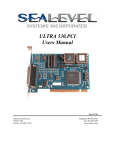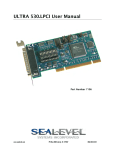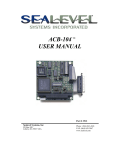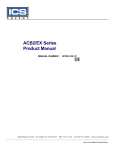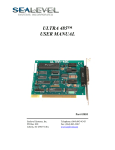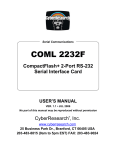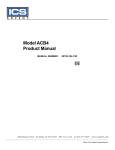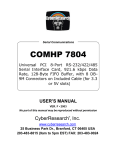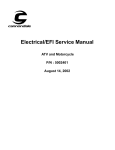Download CyberResearch RS-485 User`s manual
Transcript
® Serial Communications COML 106U-D25 Low Profile Universal PCI-Bus 1-Port RS-232/422/485/530 Serial Interface Card, 460.0 kbps Data Rate, 128-Byte FIFO Buffer, with DB-25M Connector (for 3.3V or 5V slot) COML 106U-X-D25 Low Profile Universal PCI 1-Port RS-232/422/485/530 Serial Interface Card, 460.0 kbps Data Rate, 128-Byte FIFO Buffer, with DB-25M Connector and Isochronus Communications (for 3.3V or 5V slot) USER’S MANUAL VER. 1.0 • DEC 2003 No part of this manual may be reproduced without permission CyberResearch , Inc. ® www.cyberresearch.com 25 Business Park Dr., Branford, CT 06405 USA 203-483-8815 (9am to 5pm EST) FAX: 203-483-9024 ® CyberResearch Serial Communications COML 106U(-X)-D25 ©Copyright 2002 All Rights Reserved. 2002 The information in this document is subject to change without prior notice in order to improve reliability, design, and function and does not represent a commitment on the part of CyberResearch, Inc. In no event will CyberResearch, Inc. be liable for direct, indirect, special, incidental, or consequential damages arising out of the use of or inability to use the product or documentation, even if advised of the possibility of such damages. This document contains proprietary information protected by copyright. All rights are reserved. No part of this manual may be reproduced by any mechanical, electronic, or other means in any form without prior written permission of CyberResearch, Inc. Trademarks “CyberResearch,” and “COML 106U(-X)-D25,” are trademarks of CyberResearch, Inc. Other product names mentioned herein are used for identification purposes only and may be trademarks and/or registered trademarks of their respective companies. • NOTICE • CyberResearch, Inc. does not authorize any CyberResearch product for use in life support systems, medical equipment, and/or medical devices without the written approval of the President of CyberResearch, Inc. Life support devices and systems are devices or systems which are intended for surgical implantation into the body, or to support or sustain life and whose failure to perform can be reasonably expected to result in injury. Other medical equipment includes devices used for monitoring, data acquisition, modification, or notification purposes in relation to life support, life sustaining, or vital statistic recording. CyberResearch products are not designed with the components required, are not subject to the testing required, and are not submitted to the certification required to ensure a level of reliability appropriate for the treatment and diagnosis of humans. CyberResearch, Inc. 25 Business Park Drive Branford, CT USA iii P: (203) 483-8815; F: (203) 483-9024 www.cyberresearch.com COML 106U(-X)-D25 ® CyberResearch Serial Communications Intentionally Blank iv ©Copyright 2003, CyberResearch, Inc. ® CyberResearch Serial Communications COML 106U(-X)-D25 Contents Introduction............................................................................................................................ 1 OVERVIEW .............................................................................................................................................. 1 WHAT’S INCLUDED ................................................................................................................................. 1 Card Setup.............................................................................................................................. 2 RS-485 ENABLE MODES ......................................................................................................................... 2 RS-485 MODE EXAMPLES (HEADER E5)................................................................................................. 3 ADDRESS AND IRQ SELECTION ............................................................................................................... 4 LINE TERMINATION ................................................................................................................................. 4 Figure 7 - Header E4, Line Termination ............................................................................. 5 ELECTRICAL INTERFACE SELECTION ....................................................................................................... 5 CLOCK MODES ........................................................................................................................................ 6 CLOCK MODES ........................................................................................................................................ 6 BAUD RATES AND DIVISORS FOR THE ‘DIV1’ MODE................................................................................ 7 ISOCHRONOUS CLOCKING JUMPERS ........................................................................................................ 7 Installation.............................................................................................................................. 8 OPERATING SYSTEM INSTALLATION ....................................................................................................... 8 WINDOWS 95/98/ME/NT/2000/XP......................................................................................................... 8 PHYSICAL INSTALLATION ........................................................................................................................ 9 Technical Description .......................................................................................................... 10 ISOCHRONOUS COMMUNICATIONS ........................................................................................................ 10 CONNECTOR PIN ASSIGNMENTS ............................................................................................................ 10 RS-232 Signals (DB25 Male)............................................................................................................ 10 RS-422/485/530 Pin Assignments (DB25 Male) .............................................................................. 11 Specifications ........................................................................................................................ 12 ENVIRONMENTAL SPECIFICATIONS ....................................................................................................... 12 MANUFACTURING ................................................................................................................................. 12 POWER CONSUMPTION .......................................................................................................................... 12 PHYSICAL DIMENSIONS ......................................................................................................................... 12 Appendix A - Troubleshooting ........................................................................................... 13 Appendix B - Electrical Interface....................................................................................... 15 RS-232 ................................................................................................................................................. 15 RS-422 ................................................................................................................................................. 15 RS-485 ................................................................................................................................................. 15 RS-530 ................................................................................................................................................. 15 Appendix C - Asynchronous Communications ................................................................. 16 Appendix D - Silk-Screen .................................................................................................... 17 CyberResearch, Inc. 25 Business Park Drive Branford, CT USA v P: (203) 483-8815; F: (203) 483-9024 www.cyberresearch.com COML 106U(-X)-D25 ® CyberResearch Serial Communications Appendix E - Compliance Notices ...................................................................................... 18 FEDERAL COMMUNICATIONS COMMISSION STATEMENT ....................................................................... 18 EMC DIRECTIVE STATEMENT ............................................................................................................... 18 vi ©Copyright 2002 CyberResearch, Inc. ® CyberResearch Serial Communications COML 106U(-X)-D25 Introduction Overview The CyberResearch, Inc. COML 106U is a one channel PCI Bus serial I/O adapter for the PC and compatibles. It provides one field selectable RS-232/422/485/530 serial port supporting asynchronous data rates up to 460.8K bps as well as isochronous data rates up to the speed of the supplied clock. Now, with this card, you can use your standard communications software and connect over a clocked digital communications line. Configure the port as RS-232 for standard serial COM: port requirements. Choose the RS-422 mode for long distance device connections up to 4000ft. where noise immunity and high data integrity are essential. Select RS-485 and capture data from multiple peripherals in a RS-485 multi-drop network. Up to 31 RS-485 devices can be connected to each port to automate your data collection. In both RS-232 and RS-422 modes, the card works seamlessly with the standard operating system serial driver. In RS-485 mode, our special auto-enable feature allows the RS-485 ports to be viewed by the operating system as a COM: port. This allows the standard COM: driver to be utilized for RS-485 communications. Our on-board hardware automatically handles the RS-485 driver enable. COML 106U-D25 is a one-channel universal PCI bus serial communications card. It comes with a 16850 UART, which provides deep 128-byte FIFO buffers and makes programming easy because it emulates the more common 16550 UART. COML 106U-X-D25 is similar, but it comes with a 16950 UART, which adds isochronous communication, 9-bit protocols, and programmable choice of transmission speed. We recommend it for savvy programmers. Both cards are referred to as the COML 106U unless otherwise noted. What’s Included The COML the supplier. • • • 106U is shipped with the following items. If any of these items are missing or damaged, contact COML 106U Serial I/O Adapter CyberResearch, Inc. SeaCOM Software CD Standard Profile PCI Bracket CyberResearch, Inc. 25 Business Park Drive Branford, CT USA 1 P: (203) 483-8815; F: (203) 483-9024 www.cyberresearch.com ® CyberResearch Serial Communications COML 106U(-X)-D25 Card Setup RS-485 Enable Modes RS-485 is ideal for multi-drop or network environments. RS-485 requires a tri-state driver that will allow the electrical presence of the driver to be removed from the line. The driver is in a tri-state or high impedance condition when this occurs. Only one driver may be active at a time and the other driver(s) must be tri-stated. The output modem control signal Request To Send (RTS) is typically used to control the state of the driver. Some communication software packages refer to RS-485 as RTS enable or RTS block mode transfer. One of the unique features of the COML 106U is the ability to be RS-485 compatible without the need for special software or drivers. This ability is especially useful in Windows, Windows NT, and OS/2 environments where the lower level I/O control is abstracted from the application program. This ability means that the user can effectively use the COML 106U in a RS-485 application with existing (i.e. standard RS-232) software drivers. Header E5 is used to control the RS-485 mode functions for the driver circuit. The selections are: ‘Auto’ enable (silk-screen ‘AT’). The ‘Auto’ enable feature automatically enables/disables the RS-485 interface via on board circuitry. ‘RTS’ enable (silk-screen ‘RT’) The ‘RTS’ mode uses the ‘RTS’ modem control signal to enable the RS-485 interface and provides backward compatibility with existing software products. ‘DTR’ enable (silk-screen ‘DT’) The ‘DTR’ mode uses the ‘DTR’ modem control signal to enable the RS-485 interface, provides backward compatibility with existing software products and with the Oxford Semiconductor 16C950 RS-485 enable feature ‘Output One’ enable (silk-screen ‘OP’) This mode uses the ‘OP1’ control signal to enable the RS-485 interface and provides backward compatibility with existing software products and with the Exar 16C850 RS-485 enable feature ‘No Echo’ (silk-screen ‘NE’) of E5 is used to control the RS-485 enable/disable functions for the receiver circuit and determine the state of the RS-422/485 driver. The RS-485 ‘Echo’ is the result of connecting the receiver inputs to the transmitter outputs. Every time a character is transmitted; it is also received. This can be beneficial if the software can handle echoing (i.e. using received characters to throttle the transmitter) or it can confuse the system if the software does not. To select the ‘No Echo’ mode select silk-screen position ‘NE’. 2 ©Copyright 2002 CyberResearch, Inc. ® CyberResearch Serial Communications COML 106U(-X)-D25 RS-485 Mode Examples (Header E5) AT RT DT OP NE Figure 1- Header E5, RS-422 AT RT DT OP NE Figure 2 – Header E5, RS-485 ‘Auto’ Enabled, with ‘No Echo’ AT RT DT OP NE Figure 3 - Header E5, RS-485 ‘Auto’ Enabled, with ‘Echo’ AT RT DT OP NE Figure 4 - Header E5, RS-485 ‘RTS’ Enabled, with ‘No Echo’ CyberResearch, Inc. 25 Business Park Drive Branford, CT USA 3 P: (203) 483-8815; F: (203) 483-9024 www.cyberresearch.com ® CyberResearch Serial Communications COML 106U(-X)-D25 AT RT DT OP NE Figure 5 – Header E5, RS-485 ‘RTS’ Enabled, with ‘Echo’ AT RT DT OP NE Figure 6 – Header E5, RS-485 ‘DTR’ Enabled, with No Echo Address and IRQ selection The COML 106U is automatically assigned I/O addresses and IRQs by your motherboard BIOS. Only the I/O address may be modified by the user. Adding or removing other hardware may change the assignment of I/O addresses and IRQs. Line Termination Typically, each end of the RS-485 bus must have line-terminating resistors (RS-422 terminates at the receive end only). A 120-ohm resistor is across each RS-422/485 data input in addition to a 1K-ohm pull-up/pull-down combination that biases the receiver inputs. Header E4 allows customization of this interface to specific requirements. Each jumper position corresponds to a specific portion of the interface. If multiple COML 106U adapters are configured in an RS-485 network, only the boards on each end should have jumpers T, P & P ON. Refer to the following table for each position’s operation: Name P P T L L 4 Function Adds or removes the 1K ohm pull-down resistor in the RS-422/RS-485 receiver circuit Adds or removes the 1K ohm pull-up resistor in the RS-422/RS-485 receiver circuit Adds or removes the 120 ohm termination. Connects the TX+ to RX+ for RS-485 two-wire operation. Connects the TX- to RX- for RS-485 two-wire operation. ©Copyright 2002 CyberResearch, Inc. ® CyberResearch Serial Communications COML 106U(-X)-D25 P P T L L Figure 7 - Header E4, Line Termination Electrical Interface Selection E2 RS-232 E1 RS-422 Each port on the COML 106U has the ability to be used in either RS-232 or RS-422/485. This is selectable via two 24 pin DIP-shunts at E1and E2. Please use the following illustration to aid in the configuration of your electrical interface. E2 RS-232 E1 RS-422 Figure 8 - Headers E1 & E2, RS-232 Selected Figure 9 - Headers E1 & E2, RS-422/485 Selected CyberResearch, Inc. 25 Business Park Drive Branford, CT USA 5 P: (203) 483-8815; F: (203) 483-9024 www.cyberresearch.com ® CyberResearch Serial Communications COML 106U(-X)-D25 Clock Modes The COML 106U employs a unique clocking option that allows the end user to select from divide by 8 and divide by 1 clocking modes. These modes are selected at Header E6. To select the Baud rates commonly associated with COM: ports (i.e. 2400, 4800, 9600, 19.2, … 115.2K Bps ) place the jumper in the divide by 8 mode (silk-screen D8). D D 1 8 Figure 10 - Clocking Mode ‘Divide By 8’ To select the maximum data rate (921.6K bps) place the jumper in the divide by 1 (silk-screen D1) position. D D 1 8 Figure 11 - Clocking Mode ‘Divide By 1’ 6 ©Copyright 2002 CyberResearch, Inc. ® CyberResearch Serial Communications COML 106U(-X)-D25 Baud Rates and Divisors for the ‘Div1’ mode The following table shows some common data rates and the rates you should choose to match them if using the adapter in the ‘Div1’ mode. For this Data Rate 1200 bps 2400 bps 4800 bps 9600 bps 19.2K bps 57.6 K bps 115.2 K bps 230.4K bps 460.8K bps 921.6K bps Choose this Data Rate 150 bps 300 bps 600 bps 1200 bps 2400 bps 7200 bps 14.4 K bps 28.8 K bps 57.6K bps 115.2K bps If your communications package allows the use of Baud rate divisors, choose the appropriate divisor from the following table: For this Data Rate 1200 bps 2400 bps 4800 bps 9600 bps 19.2K bps 38.4K bps 57.6K bps 115.2K bps 230.4K bps 460.8K bps 921.6K bps Choose this Divisor 768 384 192 96 48 24 16 4 3 2 1 Isochronous Clocking Jumpers The Oxford Semiconductor 16C950 allows for the reception of both transmit and receive clocks for isochronous communications (for a discussion on isochronous clocking refer to the Technical Description section). The header that provides the selection of either a modem control signal or the clock option is header E3. TXC RXC TSET RI DSR DTR Figure 12 - Header E3, Clocking and Modem control signal selection CyberResearch, Inc. 25 Business Park Drive Branford, CT USA 7 P: (203) 483-8815; F: (203) 483-9024 www.cyberresearch.com ® CyberResearch Serial Communications COML 106U(-X)-D25 Installation Operating System Installation Windows 95/98/ME/NT/2000/XP Do not install the Adapter in the machine until the software has been fully installed. 1. Start Windows. 2. Insert the CyberResearch, Inc. CD in to your CD drive. 3. If ‘Auto-Start’ is enabled for this drive the software will automatically launch. Otherwise, point your browser to the ‘Index.htm’ on the root directory of the CD 4. Select ‘Install Software’. 5. Select the Part Number for your adapter from the listing. 6. Select ‘Windows 98/ME/2000/XP’. The setup file will automatically detect the operating environment and install the proper components. Next (depending on the OS version) select the ‘Run this program from its current location’ or ‘Open’ option. Follow the information presented on the screens that follow. 7. A screen may appear with the declaration: “The publisher cannot be determined due to the problems below: Authenticode signature not found.” Please select the ‘Yes’ button and proceed with the installation. This declaration simply means that the Operating System is not aware of the driver being loaded. It will not cause any harm to your system. 8. During setup the user may specify installation directories and other preferred configurations. This program also adds entries to the system registry that are necessary for specifying the operating parameters for each driver. An uninstall option is also included to remove all registry/INI file entries from the system. 8 ©Copyright 2002 CyberResearch, Inc. ® CyberResearch Serial Communications COML 106U(-X)-D25 Physical Installation The adapter can be installed in any 5V PCI expansion slot and contains several jumper straps for each port that must be set for proper. Do not install the Adapter in the machine until the software has been fully installed. 1. Turn off PC power. Disconnect the power cord. 2. Remove the PC case cover. 3. Locate an available PCI slot and remove the blank metal slot cover. 4. Gently insert the PCI adapter into the slot. Make sure that the adapter is seated properly. 5. Replace the screw. (This is required to ensure FCC Part 15 compliance.) 6. Replace the cover. 7. Connect the power cord Installation is finished. CyberResearch, Inc. 25 Business Park Drive Branford, CT USA 9 P: (203) 483-8815; F: (203) 483-9024 www.cyberresearch.com ® CyberResearch Serial Communications COML 106U(-X)-D25 Technical Description The CyberResearch, Inc. COML 106U provides a PCI interface adapter with an additional asynchronous serial port providing a versatile interface, field selectable as RS-232 for modems, printers and plotters, as well as RS-422/485/530 for industrial automation and control applications. The COML 106U utilizes the 16850 UART. This chip features programmable baud rates, data format, interrupt control and a 128-byte input and output FIFO. The COML 106U also supports the Oxford Semiconductor 16C950. This chip features the same FIFO, and automatic RS-485 driver enable capabilities as the 16C850 and the ability to receive a clock for isochronous communications. Isochronous Communications Webster's New Collegiate Dictionary defines synchronous as "recurring or operating at exactly the same period." The majority of the serial buses in use today operate asynchronously, that is, "not synchronous" or more literally, not clocked. The same dictionary defines isochronous as "uniform in time; having equal duration; and recurring at regular intervals." In this implementation of serial communications, isochronous is defined as asynchronous framing (i.e. start, stop and parity bits) with the addition of a clock signal. This scheme allows for much higher data rates and the use of digital lines (i.e. ISDN, T1) where a clock is supplied for data multiplexing. Connector Pin Assignments RS-232 Signals (DB25 Male) Signal GND RD CTS DSR TXC RXC DCD RI TD RTS TSET DTR Name Ground Receive Data Clear To Send Data Set Ready Transmit Clock Receive Clock Data Carrier. Detect Ring Indicator Transmit Data Request to Send Transmit Signal Element Timing Data Terminal Ready Pin # 7 3 5 6 15 17 8 22 2 4 24 20 Mode Input Input Input Input Input Input Input Output Output Output Output Note: These assignments meet EIA/TIA/ANSI-232E DTE Technical Note: Please terminate any control signals that are not going to be used. The most common way to do this is connect RTS to CTS and RI. Also, connect DCD to DTR and DSR. Terminating these pins, if not used, will help insure you get the best performance from your adapter. 10 ©Copyright 2002 CyberResearch, Inc. ® CyberResearch Serial Communications COML 106U(-X)-D25 RS-422/485/530 Pin Assignments (DB25 Male) Signal GND RDB RDA CTSB CTSA DSRB DSRA DCDB DCDA TDB TDA RTSB RTSA DTRB DTRA TXCB TXCA RXCB RXCA TSETB TSETA RX+ RXCTS+ CTSDSR+ DSRDCD+ DCD TX+ TXRTS+ RTSDTR+ DTRTXC+ TXCRXC+ RXCTSET+ TSET- Name Ground Receive Positive Receive Negative Clear To Send Positive Clear To Send Negative Data Set Ready Positive Data Set Ready Negative Data Carrier Detect Positive Data Carrier Detect Negative Transmit Positive Transmit Negative Request To Send Positive Request To Send Negative Data Terminal. Ready Positive Data Terminal Ready Negative Transmit Clock Positive Transmit Clock Negative Receive Clock Positive Receive Clock Negative Terminal Timing Positive Terminal Timing Negative Pin # 7 16 3 13 5 22 6 10 8 14 2 19 4 23 20 12 15 9 17 11 24 Mode Input Input Input Input Input Input Input Input Output Output Output Output Output Output Input Input Input Input Output Output Note: These assignments meet the EIA/TIA/ANSI-530 DTE specification with the exception of Ring Indicator, which is not specified. It has been included here for compatibility with systems requiring Ring Indicator. CyberResearch, Inc. 25 Business Park Drive Branford, CT USA 11 P: (203) 483-8815; F: (203) 483-9024 www.cyberresearch.com ® CyberResearch Serial Communications COML 106U(-X)-D25 Specifications Environmental Specifications Specification Temperature Range Humidity Range Operating 0º to 70º C (32º to 158º F) 10 to 90% R.H. Non-Condensing Storage -50º to 105º C (-58º to 221º F) 10 to 90% R.H. Non-Condensing Manufacturing All of thePrinted Circuit boards used are built to UL 94V0 rating and are 100% electrically tested. These printed circuit boards are solder mask over bare copper or solder mask over tin nickel. Power Consumption Supply line Rating +12VDC 50 mA -12VDC 50 mA +5 VDC 480 mA 4.721 inches 2.536 inches 2.211 inches (11.99 cm) (6.44 cm) (5.62 cm) Physical Dimensions Board length Board Height including Goldfingers Board Height excluding Goldfingers 12 ©Copyright 2002 CyberResearch, Inc. ® CyberResearch Serial Communications COML 106U(-X)-D25 Appendix A - Troubleshooting The software is supplied with the CyberResearch, Inc. adapter and may be used in the troubleshooting procedures. Using this software and following these simple steps can eliminate most common problems without the need to call Technical Support. 1. Identify all I/O adapters currently installed in your system. This includes your on-board serial ports, controller cards, sound cards etc. The I/O addresses used by these adapters, as well as the IRQ (if any) should be identified. 2. Configure your CyberResearch, Inc. adapter so that there is no conflict with currently installed adapters. No two adapters can occupy the same I/O address. 3. Make sure the CyberResearch, Inc. adapter is using a unique IRQ. While the CyberResearc adapter does allow the sharing of IRQs, many other adapters (i.e. SCSI adapters & on-board serial ports) do not. The IRQ is typically selected by the BIOS or Operating system. Some BIOS setup software will allow changing the IRQ, but others do not. Another method of changing assigned resources is to try changing PCI slots. This will typically cause the BIOS or OS to reassign the resources. 4. Make sure the CyberResearch, Inc. adapter is securely installed in a motherboard slot. 5. When running DOS or Windows 3.x refer to the supplied CyberResearch, Inc.and this User Manual to verify that the CyberResearch, Inc. adapter is configured correctly. This software contains a diagnostic program ‘SSD’ (D:\software\seacom\Other\DOS\DIAG, where D: = the driver letter of your CDROM drive) will verify if an adapter is configured properly. This diagnostic program is written with the user in mind and is easy to use. You can use D:\software\seacom\Other\DOS\PCI\FindPCI.exe to determine resources that have been assigned to your adapter. Make sure that if available, the ‘Use Plug-n-Play” option is turned ‘OFF’ in your BIOS. Having this option set to ‘ON’ in DOS or Windows 3.x will cause erratic operations. 6. For Windows95/98/ME/NT/2000, the diagnostic tool ‘WinSSD’ is installed in the SeaCOM folder on the Start Menu during the setup process. First find the ports using the Device Manager, then use ‘WinSSD’ to verify that the ports are functional. 7. Remember that a loopback test is not possible with the ‘NE’ switch turned on. 8. Always use the CyberResearch, Inc. diagnostic software when troubleshooting a problem. This will eliminate any software issues from the equation. - CyberResearch, Inc. 25 Business Park Drive Branford, CT USA 13 P: (203) 483-8815; F: (203) 483-9024 www.cyberresearch.com COML 106U(-X)-D25 ® CyberResearch Serial Communications Appendix B - Electrical Interface RS-232 Quite possibly the most widely used communication standard is RS-232. This implementation has been defined and revised several times and is often referred to as RS-232 or EIA/TIA-232. The IBM PC computer defined the RS-232 port on a 9 pin D sub connector and subsequently the EIA/TIA approved this implementation as the EIA/TIA-574 standard. This standard is defined as the 9-Position Non-Synchronous Interface between Data Terminal Equipment and Data Circuit-Terminating Equipment Employing Serial Binary Data Interchange. Both implementations are in wide spread use and will be referred to as RS-232 in this document. RS-232 is capable of operating at data rates up to 20 Kbps at distances less than 50 ft. The absolute maximum data rate may vary due to line conditions and cable lengths. RS-232 is a single ended or unbalanced interface, meaning that a single electrical signal is compared to a common signal (ground) to determine binary logic states. The RS-232 and the EIA/TIA-574 specification define two types of interface circuits, Data Terminal Equipment (DTE) and Data Circuit-Terminating Equipment (DCE). The COML 106U is a DTE device. RS-422 The RS-422 specification defines the electrical characteristics of balanced voltage digital interface circuits. RS-422 is a differential interface that defines voltage levels and driver/receiver electrical specifications. On a differential interface, logic levels are defined by the difference in voltage between a pair of outputs or inputs. In contrast, a single ended interface, for example RS-232, defines the logic levels as the difference in voltage between a single signal and a common ground connection. Differential interfaces are typically more immune to noise or voltage spikes that may occur on the communication lines. Differential interfaces also have greater drive capabilities that allow for longer cable lengths. RS-422 is rated up to 10 Megabits per second and can have cabling 4000 feet long. RS-422 also defines driver and receiver electrical characteristics that will allow 1 driver and up to 32 receivers on the line at once. RS-422 signal levels range from 0 to +5 volts. RS-422 does not define a physical connector. RS-485 RS-485 is backwardly compatible with RS-422; however, it is optimized for partyline or multi-drop applications. The output of the RS-422/485 driver is capable of being Active (enabled) or Tri-State (disabled). This capability allows multiple ports to be connected in a multi-drop bus and selectively polled. RS-485 allows cable lengths up to 4000 feet and data rates up to 10 Megabits per second. The signal levels for RS-485 are the same as those defined by RS-422. RS-485 has electrical characteristics that allow for 32 drivers and 32 receivers to be connected to one line. This interface is ideal for multi-drop or network environments. RS-485 tri-state driver (not dual-state) will allow the electrical presence of the driver to be removed from the line. Only one driver may be active at a time and the other driver(s) must be tri-stated. RS-485 can be cabled in two ways, two wire and four wire mode. Two wire mode does not allow for full duplex communication, and requires that data be transferred in only one direction at a time. For half-duplex operation, the two transmit pins should be connected to the two receive pins (Tx+ to Rx+ and Tx- to Rx-). Four wire mode allows full duplex data transfers. RS-485 does not define a connector pin-out or a set of modem control signals. RS-485 does not define a physical connector. RS-530 RS-530 (a.k.a. EIA-530) compatibility means that RS-422 signal levels are met, and the pin-out for the DB-25 connector is specified. The EIA (Electronic Industry Association) created the RS-530 specification to detail the pin-out, and define a full set of modem control signals that can be used for regulating flow control and line status. The RS-530 specification defines two types of interface circuits, Data Terminal Equipment (DTE) and Data CircuitTerminating Equipment (DCE). The CyberResearch, Inc. adapter is a DTE interface. 14 ©Copyright 2002 CyberResearch, Inc. ® CyberResearch Serial Communications COML 106U(-X)-D25 Appendix C - Asynchronous Communications Serial data communications implies that individual bits of a character are transmitted consecutively to a receiver that assembles the bits back into a character. Data rate, error checking, handshaking, and character framing (start/stop bits) are pre-defined and must correspond at both the transmitting and receiving ends. Asynchronous communications is the standard means of serial data communication for PC compatibles and PS/2 computers. The original PC was equipped with a communication or COM: port that was designed around an 8250 Universal Asynchronous Receiver Transmitter (UART). This device allows asynchronous serial data to be transferred through a simple and straightforward programming interface. A start bit, followed by a pre-defined number of data bits (5, 6, 7, or 8) defines character boundaries for asynchronous communications. The end of the character is defined by the transmission of a pre-defined number of stop bits (usually 1, 1.5 or 2). An extra bit used for error detection is often appended before the stop bits. Idle state of line 5 to 8 Data Bits Odd, Even or Unused Remain Idle or next start bit 1 P BIT STOP 0 1 1.5 2 This special bit is called the parity bit. Parity is a simple method of determining if a data bit has been lost or corrupted during transmission. There are several methods for implementing a parity check to guard against data corruption. Common methods are called (E)ven Parity or (O)dd Parity. Sometimes parity is not used to detect errors on the data stream. This is refereed to as (N)o parity. Because each bit in asynchronous communications is sent consecutively, it is easy to generalize asynchronous communications by stating that each character is wrapped (framed) by pre-defined bits to mark the beginning and end of the serial transmission of the character. The data rate and communication parameters for asynchronous communications have to be the same at both the transmitting and receiving ends. The communication parameters are baud rate, parity, number of data bits per character, and stop bits (i.e. 9600, N, 8, 1). CyberResearch, Inc. 25 Business Park Drive Branford, CT USA 15 P: (203) 483-8815; F: (203) 483-9024 www.cyberresearch.com ® CyberResearch Serial Communications COML 106U(-X)-D25 Appendix E - Compliance Notices Federal Communications Commission Statement FCC - This equipment has been tested and found to comply with the limits for Class A digital device, pursuant to Part 15 of the FCC Rules. These limits are designed to provide reasonable protection against harmful interference when the equipment is operated in a commercial environment. This equipment generates, uses, and can radiate radio frequency energy and, if not installed and used in accordance with the instruction manual, may cause harmful interference to radio communications. Operation of this equipment in a residential area is likely to cause harmful interference in such case the user will be required to correct the interference at the users expense. EMC Directive Statement Products bearing the CE Label fulfill the requirements of the EMC directive (89/336/EEC) and of the low-voltage directive (73/23/EEC) issued by the European Commission. To obey these directives, the following European standards must be met: EN55022 Class A - “Limits and methods of measurement of radio interference characteristics of information technology equipment” EN55024 – “Information technology equipment Immunity characteristics Limits and methods of measurement”. EN60950 (IEC950) - “Safety of information technology equipment, including electrical business equipment” Warning This is a Class A Product. In a domestic environment, this product may cause radio interference in which case the user may be required to take adequate measures to prevent or correct the interference. Always use cabling provided with this product if possible. If no cable is provided or if an alternate cable is required, use high quality shielded cabling to maintain compliance with FCC/EMC directives. CyberResearch, Inc. 25 Business Park Drive Branford, CT USA 17 P: (203) 483-8815; F: (203) 483-9024 www.cyberresearch.com COML 106U(-X)-D25 ® CyberResearch Serial Communications Intentionally Blank iv ©Copyright 2003, CyberResearch, Inc. ® CyberResearch Serial Communications COML 106U(-X)-D25 Product Service Diagnosis and Debug CyberResearch, Inc. maintains technical support lines staffed by experienced Applications Engineers and Technicians. There is no charge to call and we will return your call promptly if it is received while our lines are busy. Most problems encountered with data acquisition products can be solved over the phone. Signal connections and programming are the two most common sources of difficulty. CyberResearch support personnel can help you solve these problems, especially if you are prepared for the call. To ensure your call’s overall success and expediency: 1) 2) 3) 4) 5) 6) Have the phone close to the PC so you can conveniently and quickly take action that the Applications Engineer might suggest. Be prepared to open your PC, remove boards, report back-switch or jumper settings, and possibly change settings before reinstalling the modules. Have a volt meter handy to take measurements of the signals you are trying to measure as well as the signals on the board, module, or power supply. Isolate problem areas that are not working as you expected. Have the source code to the program you are having trouble with available so that preceding and prerequisite modes can be referenced and discussed. Have the manual at hand. Also have the product’s utility disks and any other relevant disks nearby so programs and version numbers can be checked. Preparation will facilitate the diagnosis procedure, save you time, and avoid repeated calls. Here are a few preliminary actions you can take before you call which may solve some of the more common problems: 1) 2) 3) 4) Check the PC-bus power and any power supply signals. Check the voltage level of the signal between SIGNAL HIGH and SIGNAL LOW, or SIGNAL+ and SIGNAL– . It CANNOT exceed the full scale range of the board. Check the other boards in your PC or modules on the network for address and interrupt conflicts. Refer to the example programs as a baseline for comparing code. CyberResearch, Inc. 25 Business Park Drive Branford, CT USA 19 P: (203) 483-8815; F: (203) 483-9024 www.cyberresearch.com COML 106U(-X)-D25 ® CyberResearch Serial Communications Intentionally Blank 20 ©Copyright 2003, CyberResearch, Inc. ® CyberResearch Serial Communications COML 106U(-X)-D25 Warranty Notice CyberResearch, Inc. warrants that this equipment as furnished will be free from defects in material and workmanship for a period of one year from the confirmed date of purchase by the original buyer and that upon written notice of any such defect, CyberResearch, Inc. will, at its option, repair or replace the defective item under the terms of this warranty, subject to the provisions and specific exclusions listed herein. This warranty shall not apply to equipment that has been previously repaired or altered outside our plant in any way which may, in the judgment of the manufacturer, affect its reliability. Nor will it apply if the equipment has been used in a manner exceeding or inconsistent with its specifications or if the serial number has been removed. CyberResearch, Inc. does not assume any liability for consequential damages as a result from our products uses, and in any event our liability shall not exceed the original selling price of the equipment. The equipment warranty shall constitute the sole and exclusive remedy of any Buyer of Seller equipment and the sole and exclusive liability of the Seller, its successors or assigns, in connection with equipment purchased and in lieu of all other warranties expressed implied or statutory, including, but not limited to, any implied warranty of merchant ability or fitness and all other obligations or liabilities of seller, its successors or assigns. The equipment must be returned postage prepaid. Package it securely and insure it. You will be charged for parts and labor if the warranty period has expired. Returns and RMAs If a CyberResearch product has been diagnosed as being non-functional, is visibly damaged, or must be returned for any other reason, please call for an assigned RMA number. The RMA number is a key piece of information that lets us track and process returned merchandise with the fastest possible turnaround time. PLEASE CALL FOR AN RMA NUMBER! Packages returned without an RMA number will be refused! In most cases, a returned package will be refused at the receiving dock if its contents are not known. The RMA number allows us to reference the history of returned products and determine if they are meeting your application’s requirements. When you call customer service for your RMA number, you will be asked to provide information about the product you are returning, your address, and a contact person at your organization. Please make sure that the RMA number is prominently displayed on the outside of the box. • Thank You • CyberResearch, Inc. 25 Business Park Drive Branford, CT USA 21 P: (203) 483-8815; F: (203) 483-9024 www.cyberresearch.com COML 106U(-X)-D25 ® CyberResearch Serial Communications Intentionally Blank 22 ©Copyright 2003, CyberResearch, Inc. CyberResearch, Inc. 25 Business Park Drive Branford, CT 06405 USA P: (203) 483-8815; F: (203) 483-9024 www.cyberresearch.com






























